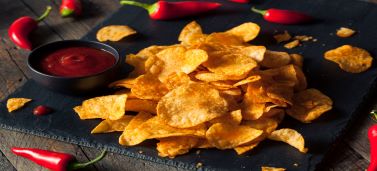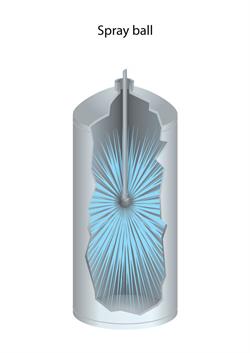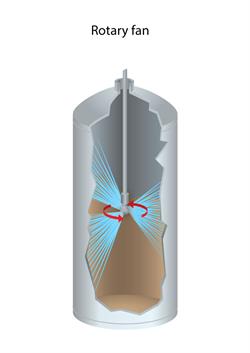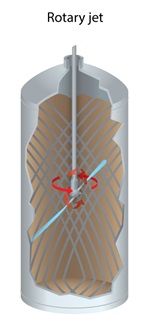
The maintenance of strict hygiene standards is of paramount importance to the food industry. Ensuring processing and storage tanks are scrupulously clean is a major consideration as a dirty tank can mean batches are ruined or contaminated. Where the ingredients leave particularly sticky, oily or tenacious residues such as crisp flavourings, the right CIP system is even more important. Then there are other challenges such as tank size, whether the ingredients cause clogging, optimising chemical consumption and, of course, minimising water consumption. And not all CIP options are equal; consideration also needs to be given to the intrinsic properties of the nozzle heads of the tank cleaning systems themselves to ensure they are suitable for incorporation into the hygienic processes required in the food and beverage sector. We look at the types of CIP systems suitable for the food and drink manufacturing industry.
Optimising tank cleaning for the food & beverage industry
Default spray balls may be supplied with the processing or storage tank or vessel but these will generally be an afterthought and are often inefficient. Efficiency gains can be made by correct cleaning head selection; often the same or better level of cleaning can be achieved in less time by changing the type of cleaning head deployed. This can, in many cases, be achieved without changing feed pumps or pipework.
Types of tank cleaner
 Static tank cleaners are nozzles with no moving parts. Most commonly this will be a spray ball type of tank cleaner consisting of a sphere with multiple holes producing many micro-jets of low impact cleaning fluid. Other types of static tank cleaners include wide angle spiral nozzles and nozzle manifolds consisting of multiple full cone spray nozzles pointing in different directions.
Static tank cleaners are nozzles with no moving parts. Most commonly this will be a spray ball type of tank cleaner consisting of a sphere with multiple holes producing many micro-jets of low impact cleaning fluid. Other types of static tank cleaners include wide angle spiral nozzles and nozzle manifolds consisting of multiple full cone spray nozzles pointing in different directions.
These types of cleaner, although water inefficient, are simple to install, low cost and reliable. This makes them the most widely used type of tank cleaning device in the food and beverage industry. Where clogging is an issue, there are innovations such as the HydroClaw which gives a robust 360 degree cleaning pattern but is able to cope with recirculated cleaning fluid that may be contaminated with pips, stems or fruit skins that would normally block traditional spray balls.

Rotary spray balls have spinning nozzle heads that distribute fluid in an omnidirectional cleaning pattern.
These nozzle can be configured to give 360, 180 or 270 degree cleaning patterns. They are fluid powered, self-lubricating
and made from hygienic materials meaning they are suitable for a wide variety of food & beverage tank cleaning applications.
This type of tank cleaner is more water efficient than static nozzle meaning tougher residues can be cleaned with less water.

Rotary jet cleaners have powerful cleaning jets that rotate in two dimensions through a
set cleaning pattern. Over the cleaning cycle the jets are brought to bear on each part of the tank
resulting in a very robust clean.This is the most water efficient type of tank cleaner and is suitable for tough
residues and for large tanks.
Fast cycle jet cleaners are very similar to rotary jet cleaners but they have been geared to run much faster.
This still results in fairly powerful cleaning action but it means the water used per cycle is greatly reduced. These
tank cleaners are used to replace inefficient spray balls to reduce the water consumption per cycle and to greatly
improve clean cycle times.
Material of construction for CIP systems for food and drink applications
Some materials are intrinsically more hygienic than others. Mostly this comes down to how porous a material will be and how easily residue can adhere to its surface. The less porous and the smoother a surface is the easier it is to clean and hence the more hygienic it is. Moreover, thought needs to be given to how the material change over time in the environment it is in. Many cleaning fluids are corrosive to certain materials so a nice shinny and hygienic surface may quickly become corroded and unhygienic if it does not have resistance to the cleaning fluid used.
316 stainless steel is normally the material of choice for hygienic spray nozzles but also the use of hastelloy nozzles is commonplace. These materials are hard wearing and corrosion resistant meaning they will keep their smooth surface finish for longer even when exposed to caustic cleaning fluids. Also high grade stainless steels can be polished to a very smooth finish leaving grime with little to adhere to.
PTFE and food grade PVDF CIP systems are also popular choices for hygienic food and beverage applications. The polymer structure of these plastics means that they produce very smooth non-stick surfaces making them very easy to clean. PTFE (brand name Teflon) has almost legendary non-stick properties and is resistant to a wider range of chemical cleaners than even high grade stainless steels.
Where applicable, the internal gears and seals (when not made from 316 stainless) will be manufactured from hygienic materials suitable for use in food and pharmaceutical applications. There are even tank cleaning CIP system heads manufactured entirely from PTFE.
Surface finish
Having a hygienic base material of construction many not be enough. The surface finish / polish is often what counts when it comes to maintaining hygiene. Well-polished, smooth surfaces mean that microbes or residues literally have fewer places to cling onto. This means that cleaning is easier.
A surface’s roughness is measured by looking at the average peaks and troughs on the surface from a mean line. As such it is measured as a distance (the Ra rating). For most surfaces this is obviously a very small distance and is normally quantified in micro metres. A normal raw piece of milled stainless steel will have an Ra of around 6 micrometres. The generally accepted standard for a sanitary surface is 0.8 micrometres. For biotech or pharmaceutical applications some standards dictate Ra of 0.5 micrometres. Very fine ultra-pure environment (0.25 Ra) finishes are also possible for some products and materials.
Self-cleaning
If tank cleaning equipment is installed permanently within a vessel then it needs to be self-cleaning. Otherwise the cleaning heads themselves would become a potential source of contamination. Many CIP cleaning heads are fully self-cleaning machines. A small amount of the cleaning fluid is directed over the surface of the cleaner to ensure that it remain residue free. This, coupled with the use of hygienic materials of construction and good surface finishes (see above), means they are suitable for installation in food processing tanks.
For more information about or advice on your CIP food and beverage tank cleaning system, please call SNP on 01273 400092.


.jpg?sfvrsn=1dc1fc92_2&MaxWidth=150&MaxHeight=&ScaleUp=false&Quality=High&Method=ResizeFitToAreaArguments&Signature=97A0ACAB321BF15182AC384FFE77861A)

